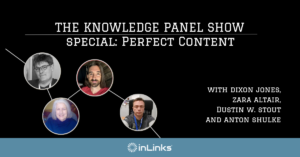
The Knowledge Panel Show Special: Perfect Content
Join the author and content writer, Zara Altair as she works with Dixon Jones from


Join the author and content writer, Zara Altair as she works with Dixon Jones from

“How to build an SEO-friendly content marketing strategy” – InLinks Knowledge Panel episode 38 with

“What can SEO learn from Digital PR?” is the InLinks Knowledge Panel with Darren Kingman,

What does it take to become an SEO freelancer? And how do you run a

This month the Knowledge Panel show discusses how to use your analytics package for content-driven

In this episode of the Knowledge Panel Show, we’re discussing technical SEO in 2023, with

Is it a good idea to use AI to generate content? And if so, what

It’s often the case that SEOs and creative content producers don’t work closely enough together.

Are you working too hard? How do you protect your mental and physical health in

Are you thinking of moving on to a different SEO role in 2023? In episode

What link building strategies work now? Joining Dixon Jones on Episode 29 of the Knowledge

What are the key elements of digital PR that cross paths with SEO? That’s what

A discussion on how you can be more targeted with the traffic you are driving

How should you be using log files to assist your SEO? That’s what we’re discussing

How do you keep your SEO clients so satisfied that they’ll stay for a long

Can SEO and PPC work together? In this episode of “The Knowledge Panel,” we find

Is doing SEO in Spain any different to doing SEO in English-speaking countries? In this

What are some of the most effective technical SEO quick wins in 2022? That’s what

How do you ensure that websites that are built with JavaScript are easy for search
User experience is constantly talked about as a progressive part of an SEO strategy –
Give us a call or drop us a message using the blue chat icon.
You may also Request a Demo
InLinks UK | Dixon Jones